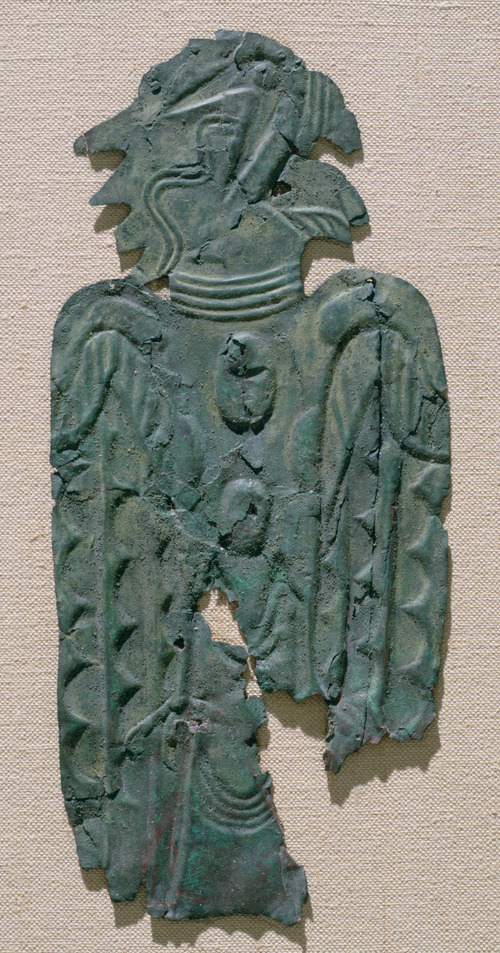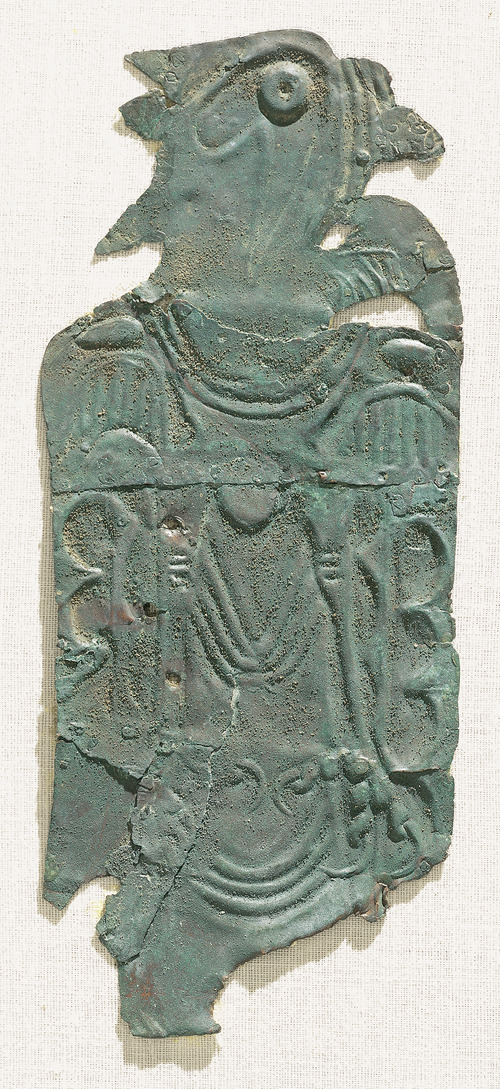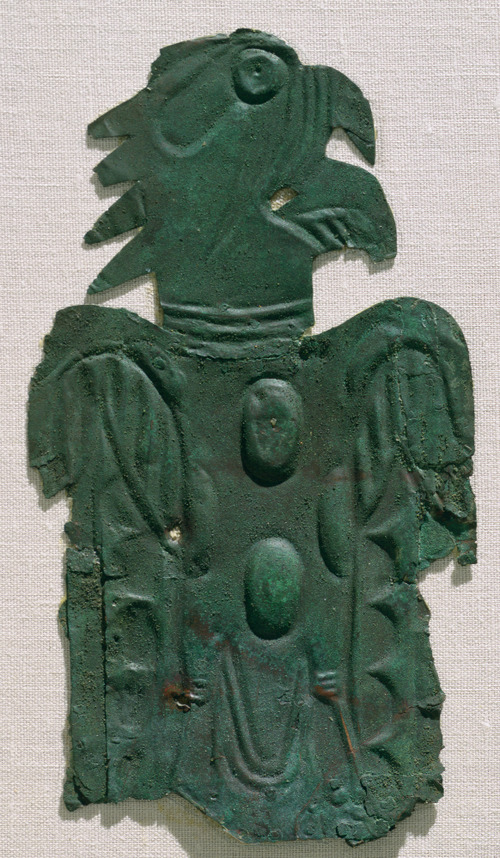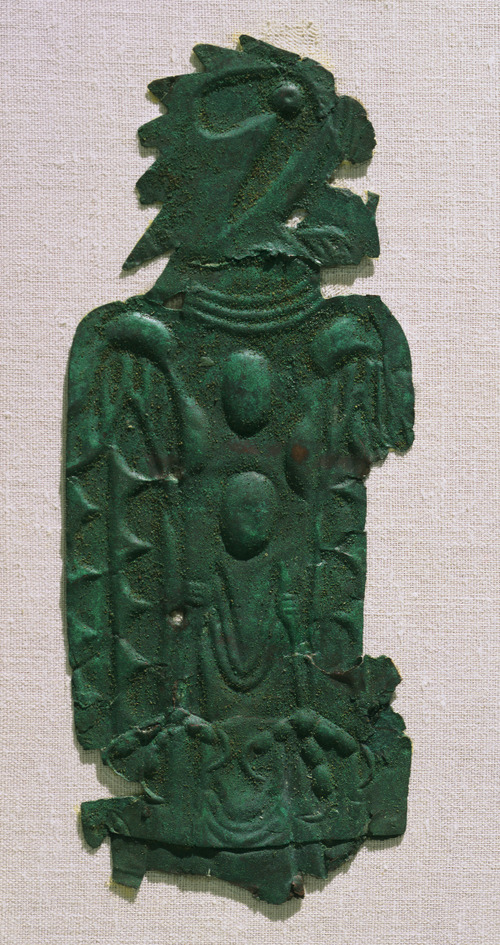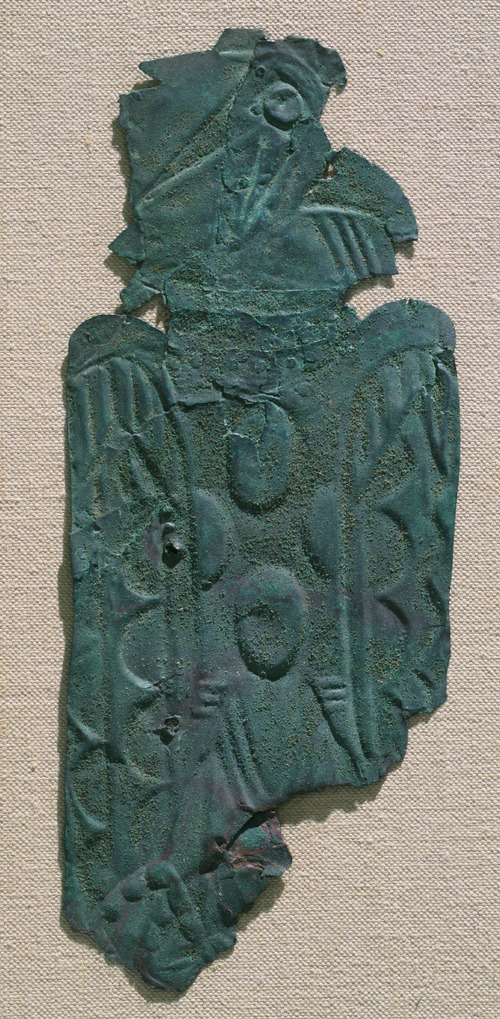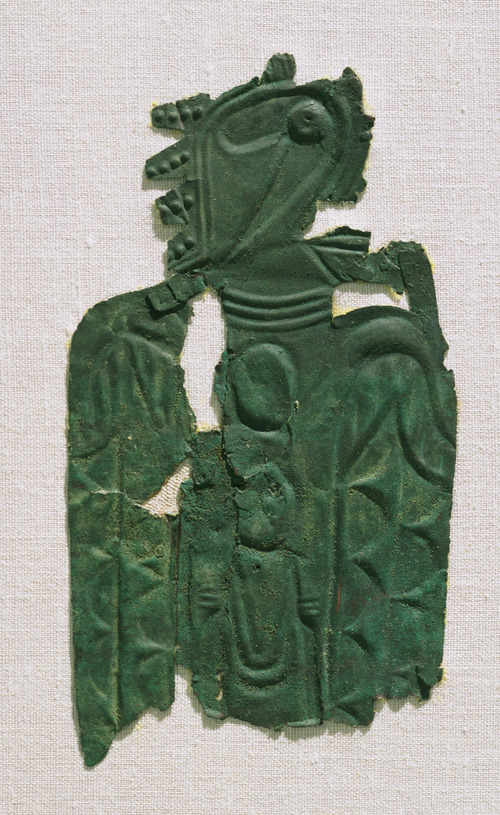Unknown, Wulfing Repoussé Plaques, c. 1200–1400
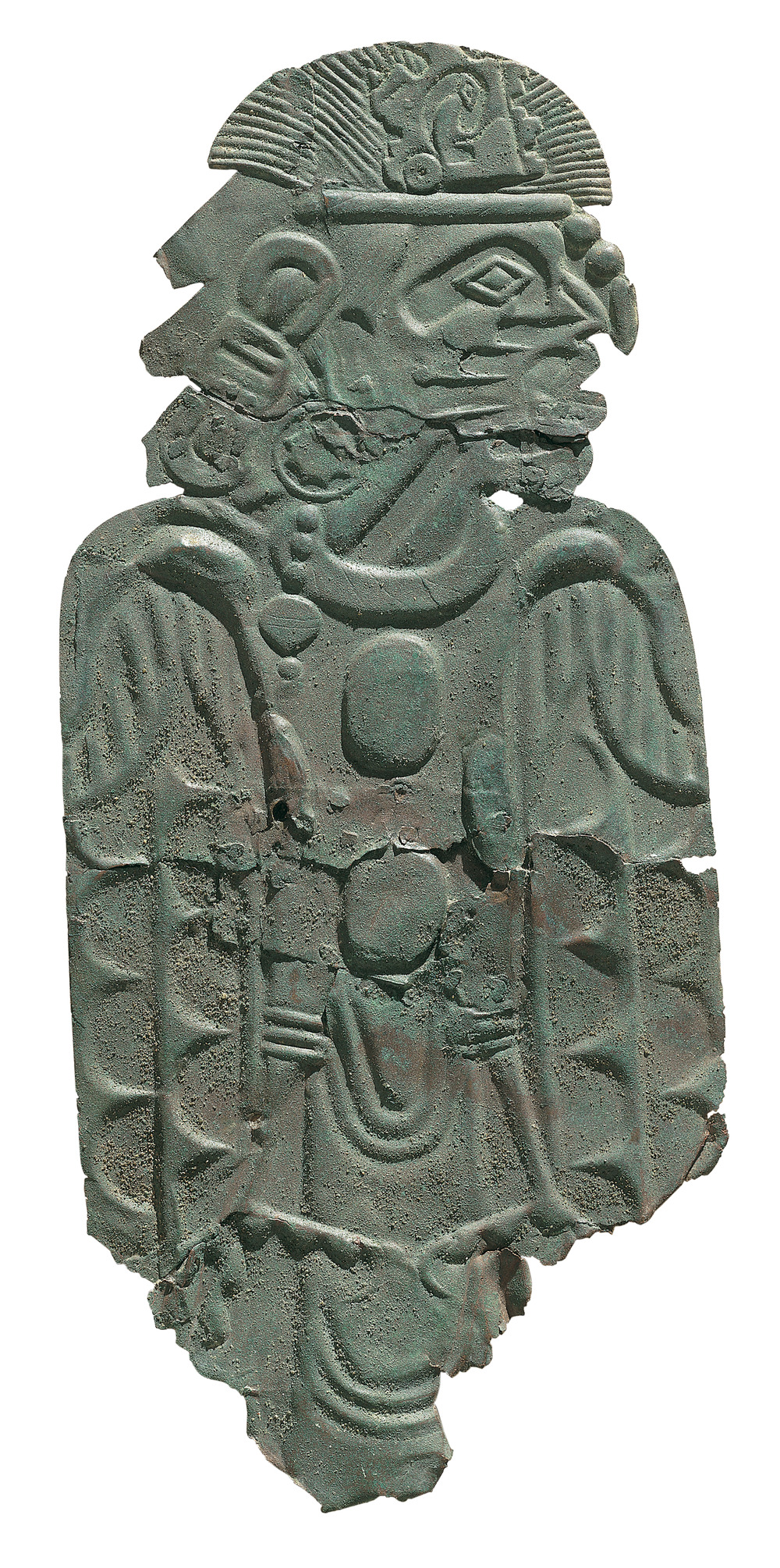
Matthew H. Robb
Chief Curator, Fowler Museum at the University of California, Los Angeles
Formerly associate curator in charge of the Department of the Arts of Africa, Oceania, and the Americas, Saint Louis Art Museum
In 1910, in his survey of the antiquities of Missouri, the anthropologist Gerard Fowke published images of eight copper plates that had recently been discovered by a farmer outside the town of Malden, in Dunklin County, just north of the state’s southeastern boot heel.1 Few comparable objects from the ancient Midwest were known at the time, so these plates, with their repoussé avian images, almost instantly achieved canonical status soon after their publication.
The intervening century has seen the discovery of similar objects in locales across the Midwest and Southeast, from the site of Spiro, Oklahoma, to Etowah Mounds in Georgia, as well as other sites in Missouri, Illinois, Alabama, and Florida.2 Scholars in the mid-twentieth century, noting the consistency of iconography on copper objects, ceramics, and incised shells, suggested the existence of a shared cultural tradition they called the Southeastern Ceremonial Complex, or SECC, lasting from the tenth to seventeenth centuries, during what is called the Mississippian period.3
Throughout the Mississippian period, centers of ritual, economic, and political power waxed and waned, but their reliance on exotic materials such as copper remained relatively constant. Although today copper may not seem a particularly exotic substance and knowledge of its material properties is not particularly esoteric, the ancient inhabitants of the Midwest saw the landscape and its contents in very different terms. Copper work has a history going back thousands of years in North America, with distinct episodes in the Late Archaic (c. 3000–c. 1000 BC), Woodlands (c. 1000 BC–c. 1000 AD), and Mississippian (c. 900–c. 1500 AD) periods.4 For all these peoples the diligent search for copper sources and an understanding of copper’s manipulation required generations of patient preparation and transmission of experience. This knowledge was protected and preserved by subsequent generations, helping some members of the elite classes enhance and project their power.
The mounds of Cahokia in Illinois (as well as those that once existed in the urban grid of St. Louis) were a central place in this network of Mississippian period sites across the Midwest and Southeast. Indeed, some have argued that much of the iconography now associated with the SECC drew on imagery that had earlier developed in and around Missouri and Illinois, indicating that Cahokia was where the SECC was first articulated and amplified.5 Elites in centers like Cahokia—along with their peers at Spiro, Etowah, and Moundville, Alabama, and smaller sites in between—relied on the acquisition, manufacture, and trade of valuable materials like copper. For them, copper and the objects crafted out of it were simultaneously a manifestation and symbol of the esoteric knowledge that was a primary cultural currency binding the landscape. Yet, despite our increased understanding of the iconographic, cultural, and economic system that produced them, the Wulfing plates retain a great deal of mystery, as there are still many questions about their precise function and meaning. In light of this, it is worth revisiting some primary accounts to understand how we know what we do know about them.
In his survey of 1910, Fowke gave the account of Max Groomes, who found the plaques while plowing a field owned by Mrs. W. O. Baldwin just south of the town of Malden:
[Groomes] was plowing much deeper than usual, probably 16 or 18 inches. His attention was attracted by something shining or glittering on the land turned over by his plow at this point, and he stopped to examine it. He found a few small scraps of copper. On looking at the bottom of the furrow, whence they had come, he found that his plow had struck the upper end of these copper pieces, which lay in close contact, "with the heads down," and inclined at an angle of 45°. He saw no evidence that they had ever been wrapped in cloth or any other substance, separately or together. He dug around them with his pocketknife, the loose sand and soil being easily removed, and drew them out of the earth one by one. There was something with them which looked to him like a small piece of "slate" [shale], such as he had frequently noticed in this ground in plowing. Possibly this was all that remained of a sun-dried or softburned clay vessel which went to pieces in the earth. There was also a small amount of some "white substance," not identified, none of which was preserved. Mr. Groomes is positive in his statement that the specimens were in immediate contact, as he lifted them out one after another, and that very little earth had worked in between them.6
Groomes’s family members reminisced about the discovery fifty years later; these and contemporary accounts suggest that Groomes sold the objects to Bob Wade and A. I. Davis, and that they were variously on view on the Groomes’s porch, at a local school, and then a general store owned by Davis before the latter sold the objects to Wulfing.7 These events must have taken place by 1907, as a letter written in May of that year by Wulfing to Davis constitutes the earliest extant discussion of the plaques, and suggests they were already in Wulfing’s possession.8 Wulfing sent the letter hoping to find out more about the discovery; his straightforward questions and Davis’s equally terse replies largely corroborate the story Groomes told Fowke.9
From all these accounts we learn something of the haphazard manner in which ancient objects of the Midwest were often treated in the early twentieth century. Wulfing’s fleeting interest in objects from ancient Missouri appears idiosyncratic when compared with his long-standing interest in classical antiquities, but when we consider that his collection consisted largely of ancient coins, the potential relevance of ancient American copper becomes clearer.10 None of the literature of the day explicitly invokes currency when discussing the plaques, but for a numismatist the formal connection between the iconography on antique coins and the imagery on the thin plates from outside Malden was surely inescapable. More importantly, these early accounts are valuable because they underscore the isolation of the plates in the local landscape, suggesting that the plates did not come from a burial context. In fact the closest group of mounds was some nine miles away.
Although they were on display at the Saint Louis Art Museum for many years, the plates did not receive sustained scholarly attention until Virginia Watson, then a lecturer at Washington University in St. Louis, published a comprehensive study in 1950 documenting their condition and variance in execution of design. She paid particular attention to the extensive riveting, crucial details suggesting careful preservation in ancient times.11 It is in fact these repairs that help us understand that the plates are probably earlier than their findspot near the surface would indicate. Without a firm archaeological context, specific dates are speculative, based on stylistic comparisons with other similar objects associated with more secure contexts.12 Aside from these eight plates from Malden, the known corpus— about five dozen identified to date—almost always came from burials. The most famous are from Spiro and Etowah, where copper plates and other objects have been found in great quantity, but examples from smaller sites are stylistically close to the six all-avian Wulfing plates. As categorized by James A. Brown, Wulfing’s plates are characteristic of the Late Braden style and probably date to the later thirteenth or fourteenth century, following on the apparent elaboration of the Classic Braden style at and near Cahokia around AD 1100–1200.13
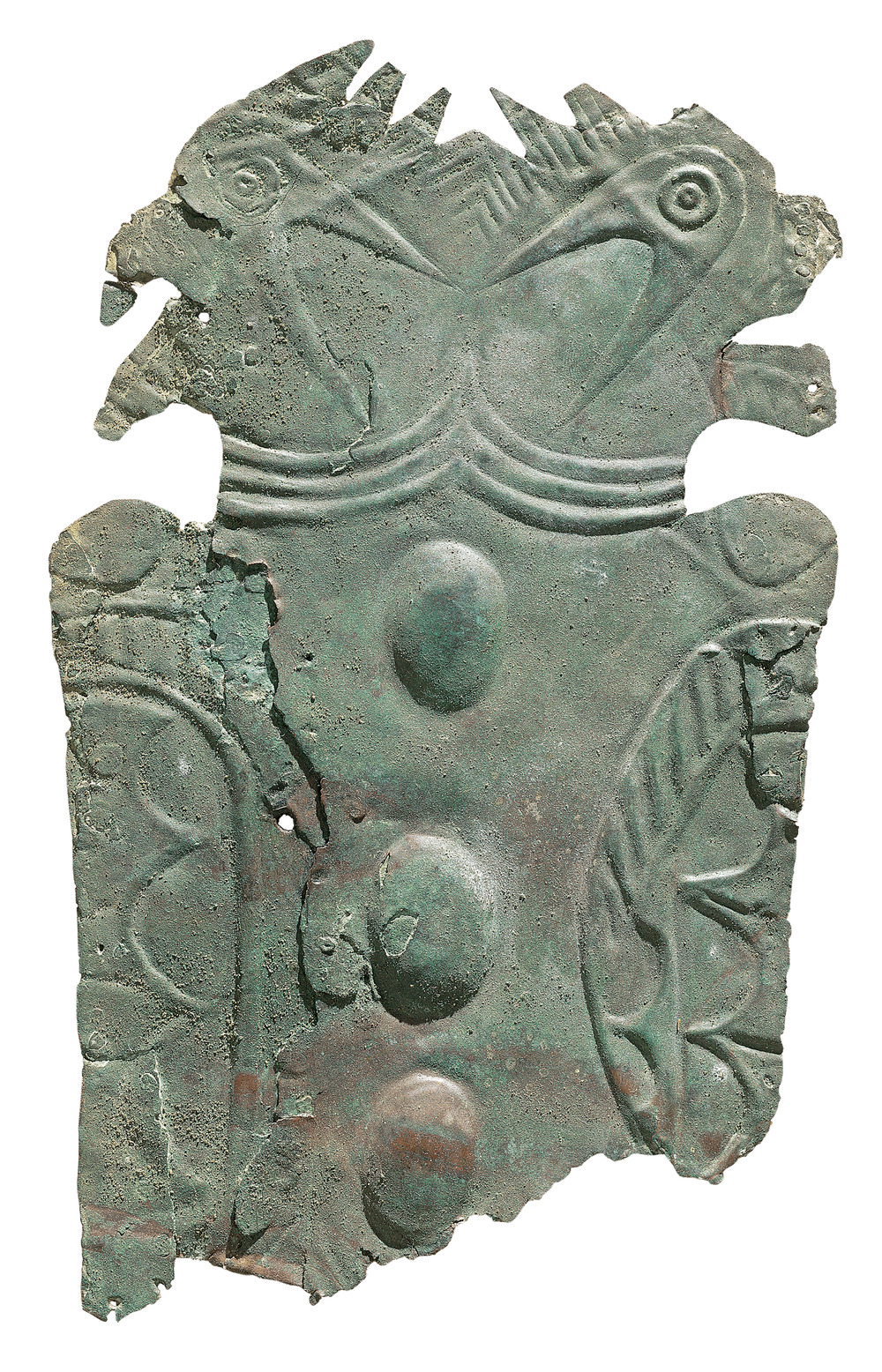
Of the eight, the plate with the human head (WU 3679) and the plate with two avian heads (WU 3680) are the most distinctive. Both plates offer suggestive formal and stylistic links to larger and more elaborately articulated plates from burials at Etowah.14 The Wulfing and Etowah plates, as well as the other known copper avian plates, are thought to depict aspects of the Birdman, a major character in Mississippian iconography whose roles touch on the various domains of warfare, ritual dancing, and sports.15 The human head of WU 3679 most closely matches the veristic depictions of the gures on certain Etowah objects. The two-headed bird of WU 3680 most closely resembles the composition of the “fighting birds” plate recovered from another Etowah burial.16 The remaining six plates more clearly represent avians derived from peregrine falcons, with their characteristic wing and head plumage patterns.9
The small upward-facing head seen at the top of WU 3679, with its crenellated diadem, immediately recalls a small wooden effigy mask (originally probably sheathed in copper) from the Emmons site in Illinois,18 as well as trophy heads wielded by the characters on other plates. The Wulfing plates and their companions are, in this respect, objects about other objects. On another plate from Etowah, a human figure is shown wearing an avian plaque as a headdress, giving us a hint as to their possible function.19 At some point, in some places, these plaques became self-reflexive signifiers of political power and elite status as well as bearers of iconographic data. Their mere inclusion and presentation as part of a ruler’s costume complemented and may have eventually superseded their function as transmitters of ritual knowledge.
The prestige surrounding the creation and presentation of these plates and other objects appears to have originated at Cahokia some centuries before.20 Although no such plates have ever been found at the site, excavations of a copper workshop at Mound 34, near Monk’s Mound, indicate the metal’s prominent place in the site’s ritual economy.21 In addition, avian imagery occupies a central place in Cahokian visual culture, as exemplified by a sandstone tablet, incised with an image of the Birdman, that was recovered from Monk’s Mound.22 Even more striking was an astonishing burial in Mound 72 of a middle-aged man on top of thousands of shell beads laid out in the silhouette of a bird, suggesting the beginnings of a visual and material culture that would come to play an important role in the developing interaction sphere beyond Cahokia.23
This interaction between the elites of Mississippian centers would have depended on the creation and maintenance of a visual symbol system that was not tied to a specific language and could be readily recorded on portable, semipermanent materials.24 This is part of the power that resides in the Wulfing plates. In this interpretation, they compressed the ritualized knowledge surrounding something like the Mound 72 burial into a compact and transferable package of iconography, allowing a religious practitioner, leader, or merchant to move across the landscape with this distilled and essential knowledge carefully protected. Just as the buried man was arrayed inside the beaded silhouette of a bird, the Wulfing plates layer the human form within and on top of avian outlines. Are the Wulfing plates and this burial simply articulations of the same ideological system, or could the layering of the imagery on the copper plates somehow describe and proscribe the sequence of ritual actions actually carried out at Cahokia? Although we will likely not be able to answer such questions, the creation, acquisition, and presentation of such ritual paraphernalia and their attending esoteric information would have allowed rulers and elites to proclaim their own political legitimacy. The plates eventually became prized in their own right, preserved as heirlooms and diligently repaired over generations, even as some of the precise knowledge surrounding their iconography and original purpose slowly spalled away.25
This is part of what has made the Wulfing plates so mysterious since their discovery. Their extraordinary isolation in the local landscape is exceptionally rare.26 If we could be certain that the plates were cached in Mississippian times, we could more reliably construct hypotheses about the nature of way-finding, localized cartographies, and place-making, but it is possible, given their proximity to the surface, that the plates were hidden centuries after they were originally made. Perhaps the spot in which they were buried was once not isolated at all but served as a marker of centrality—this area of Missouri is in fact roughly equidistant from Spiro and Etowah, arguably the two most significant heirs to Cahokia’s power and dominance. Perhaps a now-vanished feature on the landscape signaled to a journeying merchant, warrior, or artist where the objects had been safely stored. Perhaps the plaques served as a kind of news bulletin, conveying and dispersing the inherited wealth and wisdom of an individual like that buried in Cahokia’s Mound 72. The Wulfing plates are at once promising and baffling: their geographic proximity entices us with possible insight into regional ritual significance, while chronological and cultural distance obscures many of these details.
- 1 Gerard Fowke, Antiquities of Central and Southeastern Missouri, Bulletin of the Smithsonian Institution Bureau of American Ethnology, no. 37 (Washington, DC: Government Printing Office, 1910), 98; pls. 15–19.
- 2 For a comprehensive census of these and other copper plates, see Jeffrey P. Brain and Philip Phillips, Shell Gorgets: Styles of the Late Prehistoric and Protohistoric Southeast (Cambridge, MA: Peabody Museum Press, 1996), 363–71.
- 3 For the seminal articulation of the SECC, see Antonio J. Waring, Jr. and Preston Holder, “A Prehistoric Ceremonial Complex in the Southeastern United States,” American Anthropologist 47, no. 1 (Jan–March 1945): 1–34. Recently, scholars have proposed identifying this tradition more broadly as the Mississippian Ideological Interaction Sphere, or MIIS. In their view, this name more accurately reflects the elaborate array of multi-ethnic exchanges bound together by a pan-regional visual symbol system; see F. Kent Reilly and James F. Garber, “Introduction,” in Ancient Objects and Sacred Realms: Interpretations of Mississippian Iconography (Austin, TX: University of Texas Press, 2007), 3.
- 4 For a brief overview of these periods and the varied uses to which they put copper, see Amelia M. Trevelyan, Miskwabik, Metal of Ritual: Metallurgy in Precontact Eastern North America (Lexington: University Press of Kentucky, 2004), 9–14.
- 5 See, for example, James A. Brown and John E. Kelly, “Cahokia and the Southeastern Ceremonial Complex,” in Mounds, Modoc, and Mesoamerica: Papers in Honor of Melvin L. Fowler, ed. Steven R. Ahler and Melvin L. Fowler (Springfield: Illinois State Museum, 2000), 219; see also Carol Diaz-Granados and James R. Duncan, The Petroglyphs and Pictographs of Missouri (Tuscaloosa: University of Alabama Press, 2000), Table 6.1.
- 6 Fowke, Antiquities, 98.
- 7 See Bill Dye, “Dunklin Field Gives up Mysterious Plates,” The Daily Dunklin Democrat, October 21, 1957; compare with Louis Houck, A History of Missouri from the Earliest Explorations and Settlements until the Admission of the State into the Union (Chicago, IL: R.R. Donnelley & Sons Company, 1908), 402–3. Wulfing gave the plates to Washington University in 1937.
- 8 John Max Wulfing to A. I. Davis, March 1, 1907, J. Max Wulfing Collection, Washington University Libraries, Department of Special Collections, St. Louis.
- 9 Ibid.
- 10 For more on Wulfing’s interest in numismatics, see Roy C. Flickinger, “John Max Wulfing,” The Classical Journal 24, no. 7 (1929): 481-82. His coin collection was given to Washington University in 1928.
- 11 Virginia Watson, The Wulfing Plates: Products of Prehistoric Americans (St. Louis: Washington University, 1950). Watson speculated that the copper itself probably came from the deposits of Upper Michigan, but subsequent researchers have determined that copper was also available (if not always easily found) throughout the southeastern portion of the United States. See Vernon J. Hurst and Lewis H. Larson Jr., “On the Source of Copper at the Etowah Site, Georgia,” American Antiquity 24, no. 2 (October 1958): 177–81.
- 12 See James A. Brown, “Sequencing the Braden Style within Mississippian Period Art and Iconography,” in Reilly and Garber, Ancient Objects and Sacred Realms, 237–41, fig. 9.8.
- 13 See James A. Brown, “The Cahokian Expression: Creating Court and Cult,“ in Hero, Hawk, and Open Hand: American Indian Art of the Ancient Midwest and South, ed. Richard F. Townsend (Chicago: Art Institute of Chicago; New Haven, CT: Yale University Press, 2004), 105-24.
- 14 For a discussion of the Rogan plates (named after the archaeologist John P. Rogan, who excavated Etowah in 1884) and their sequence in Mound C’s construction history, see Adam King, “Power and the Sacred: Mound C and the Etowah Chiefdom,” in Townsend, Hero, Hawk, 151–66.
- 15 See James A. Brown, “On the Identity of the Birdman within Mississippian Period Art and Iconography,“ in Ancient Objects and Sacred Realms, 56–106.
- 16 See Douglas S. Byers, “The Restoration and Preservation of Some Objects from Etowah,” American Antiquity 28, no. 2 (1962): fig. 10.
- 17 Ibid.
- 18 See Townsend, Hero, Hawk, no. 273.
- 19 See Brain and Phillips, Shell Gorgets, 370.
- 20 See Brown and Kelly, “Cahokia.”
- 21 See John E. Kelly, Lucretia S. Kelly, and James A. Brown, Summary of 2008 Field Excavations to Locate the Copper Workshop in the Mound 34 Area (Cahokia, IL: Cahokia Mounds Museum Society, 2009).
- 22 See Biloine W. Young and Melvin L. Fowler, Cahokia, the Great Native American Metropolis (Urbana: University of Illinois Press, 2000), 162–64.
- 23 For a discussion of Mound 72, see Robert J. Watson, “Sacred Landscapes at Cahokia: Mound 72 and the Mound 72 Precinct,” in Ahler, Mounds, Modoc, and Mesoamerica, and Brown, “On the Identity of the Birdman.”
- 24 See Reilly and Garber, introduction, 3.
- 25 See Brown, “Sequencing the Braden Style,” 237–39.
- 26 See Claire Garber Goodman and Anne-Marie E. Cantwell, Copper Artifacts in Late Eastern Woodlands Prehistory (Evanston, IL: Center for American Archeology at Northwestern University, 1984), 67.


